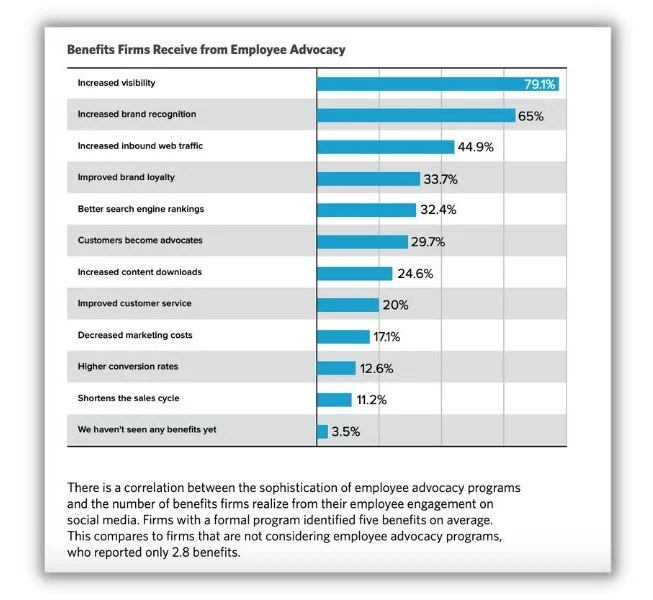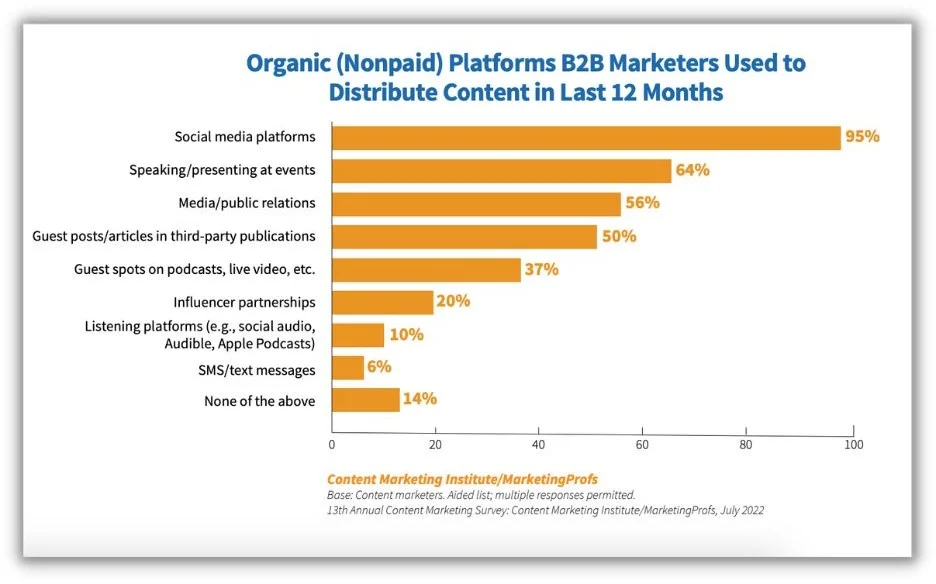Creating content is great, but it’s only the first step in your marketing strategy. When you write articles, put together reports, or record videos, you need to make sure you promote them effectively, too. That means testing out new content distribution strategies whenever you can.
Today, we’re sharing 17 content distribution strategies you can try and test this year. But first, let’s go over what counts as content promotion.
Contents
- What is content distribution?
- 17 content distribution strategies to start now
- Repurpose in another format
- Brand all of your visuals
- Optimize content for SEO
- Include links in relevant blogs or guides
- Post on social platforms
- Plug content on a podcast
- Syndicate your blogs
- Share with your email mailing list
- Pitch your content to related newsletters
- Share on forums
- Partner with influencers
- Promote with banners, pop-ups, or sidebar CTAs
- Credit and tag your sources
- Encourage your employees
- Let your community know
- Write a guest blog post
- Run pad ads
What is content distribution?
Content distribution, or content promotion, is the process of distributing your blogs, articles, infographics, webinars, and more to reach a wider audience than their initial publication.
Here’s an example. This small brand regularly publishes blog posts and then shares links through its Instagram bio. It creates Instagram posts to publicise the new content.

By sharing or even repurposing your content in multiple ways throughout your marketing strategy, you can increase its visibility and reach among your target audience. This has benefits beyond a single piece of content, including increased brand awareness, a stronger competitive edge, and even more conversion opportunities.
If you’re investing the time, effort, and (often) budget to create high-quality content, you want to make it as beneficial to your business as possible.
📣 Free guide >>> 25 Ways to Increase Traffic to Your Website (Fast!)
17 content distribution strategies to start testing now
Here are 17 content promotion strategies that will help you distribute your content, reach a wider audience, and build your brand. Whether you’re working to put a content promotion plan together or already have a solid strategy, take a look and see what you can test out this year.
1. Repurpose in another format
Content repurposing is the first strategy we’re sharing because it’s the most fundamental and presents the most opportunity. If you have a blog post, turn it into a video for YouTube. If you have a longer video, splice that up into shorter, bite-sized clips for social content. If you have a data-packed report, pick out the most compelling headlines to make shareable graphics.

Shopify has two versions of this content: a YouTube video and a blog post that explains drop-shipping.
Creating content takes a lot of time—ideating, researching, developing, editing, finalizing, and launching. That’s why content promotion across as many channels as possible is so important. The best way to create even more possibilities for promoting and sharing your content is by repurposing and repackaging it in another medium.
This extends both the reach and the life of your content. By turning blogs into videos or long-form videos into short clips, you can distribute them across different channels and reach new audiences. When you repackage, it takes less time than creating pieces from scratch, but you’re also creating fresh content, which keeps your content new for longer.
This, of course, has its limits. You don’t want to seem like you’re repeating yourself constantly to your community. And it’s not always feasible or effective to repurpose a blog into a video or a guide into podcast episodes. That’s what the rest of the strategies here are for.
2. Brand all of your visuals
If you ensure that all of the visuals in your whitepapers, articles, or blog posts are branded, you can share those graphics elsewhere. You can share these as eye-catching posts on social media to increase brand awareness, use these elements in other pieces to create internal links, and even optimize your image SEO for organic reach with the graphics alone.
Take this example from Semrush. It’s a simple but effective graphic of the elements of a content marketing strategy with the brand’s logo in the corner. It’s also the first result in an image search for content marketing strategy.

This is something you bake into your content creation process. Like the Semrush example above, it doesn’t have to be extensive. Make sure graphics feature your brand colors. Include your logo at the bottom of any charts or tables. Take the time to optimize for SEO, which leads to our next strategy.
3. Optimize content for SEO
Organic search is an opportunity for content promotion. If you’re writing a blog post, publishing a report, or even releasing a video series, getting your content on the SERP offers you the chance to reach a wider audience through another channel.
Take advantage of this by improving your SEO strategy this year. Whether it’s spending more time considering long-tail keywords during your ideation phase or focusing on improving your local SEO site-wide, it’s an opportunity to get your content out there.
4. Include links in relevant blogs or guides
Internal linking is important for your SEO, but it’s also a chance to promote your content to interested readers who already trust your brand.

This Etsy blog post about using the color black as a wedding theme links to a blog on trending wedding colors. Relevant research for event planning.
But in-context linking is only one way to help promote content with internal links. You can link to high-value content from your company’s educational materials, add call-outs to your blogs, or add clickable links to your whitepapers. To learn more about getting creative, check out this guide to internal linking. (See what we did there?)
🛑 Not getting enough traffic from search engines? Download this free guide and get on the first page of Google.
5. Post on social platforms
Promoting your content on social media is important. Even if you don’t have a large following, posting can broaden your reach and grow your audience. This could be as simple as writing a quick intro and including a link to your post on X (formerly Twitter) or Threads if you’re on there. You can also use major takeaways to record a quick video for Instagram or create a slideshow with major takeaways on LinkedIn.

Example of a LinkedIn slideshow.
The most important thing is to start sharing and pay attention to the responses. Figure out what works for your brand, your audience, and your typical content production.
6. Plug content on a podcast
Podcasts are excellent places for sharing recommendations and plugging content naturally. You’re not dropping a link (except in the show notes), but you can reference thought leadership, share data and findings, or use a case study as an example. The spoken medium feels more authentic, and if your content comes up naturally on your brand’s own podcast or during a guest appearance, that’s another great way to promote it.
You can run podcast ads if you’re not running a podcast or looking to take on guest spots. These still offer the same benefits. In fact, in a study by Acast, 72% of podcast listeners reported that they visit an advertiser’s website after hearing a brand’s spot, and 62% of listeners reported making a purchase after hearing a podcast ad.
7. Syndicate your blogs
Some publications syndicate content, meaning they republish blog posts or articles as excerpts or in their entirety. How this works will depend on the publication. Some will automatically republish all of your content, while others ask you to submit it for syndication.

For example, this article in Fast Company includes a “republished with permission” note.
Here’s how to find sites that might syndicate your content: In a search engine, enter “republished with permission,” plus a keyword related to your brand or content. The results are sites that likely syndicate content in your area of expertise.
8. Share with your email mailing list
Your subscribers have already indicated an interest in your brand and offering. Send them your content, too. This could be a regular newsletter to share links to new releases if you have a full and varied content calendar, or a one-off email if your content creation is slow and steady.
Email is an effective content promotion method. According to the Content Marketing Institute, 69% of B2B marketers distribute content through their own newsletters, and 67% share content in other emails.
👋 Use these email marketing templates to write better emails faster.
9. Pitch your content to related newsletters
You should definitely send emails to your own audience, but that’s not the only way to get your content into newsletters. There are many regular newsletters that aggregate industry content or share a variety of links with their audience. Pitch your best content—think high-value articles penned by an industry leader or an annual report with compelling data—to include here.
10. Share on forums
Forums like Quora and Reddit are potential channels for your content distribution, too. If you have a free course or helpful guide, you can share that. Look for people asking questions about your topic, then answer with a helpful explanation and the link.

This Reddit post has a link to a tool that seems helpful, not purely self-promo.
Keep in mind that no one wants to be spammed. Make sure you’re sharing relevant content and doing so selectively.
11. Partner with influencers
If you have the budget to promote your content, try working with influencers in your industry to get your content in front of more people. Here’s a great example. In the video below, marketing influencer Laurie Wang breaks down the fundamentals of digital marketing. She also shares templates from HubSpot, which is the sponsor of the video.

It’s also worth noting that this influencer has 15,000 subscribers on YouTube. That’s closer to a micro-influencer, which can be more affordable.
12. Promote with banners, pop-ups, or sidebar CTAs
Your content promotion doesn’t always need to be focused on reaching a new audience. It can also be a push to engage people who are already visiting your site further, whether they’re warm leads checking out cornerstone content one more time or new contacts who landed on your top-of-funnel blog post for the first time.
In those cases, you can promote your content to your website visitors through pop-ups, banners, and sidebar calls to action. The key is to promote high-value, relevant content in a compelling but non-intrusive way.
💡 Calls to action are the most important copy on the page. Get this free guide filled with compelling CTA phrases you can swipe today.
13. Credit and tag your sources
If your content contains references to other people’s work, try tagging them in your social posts, especially on LinkedIn or Instagram. Mention found a compelling correlation between tags and engagement for Instagram posts.

More engagement will help more social media users find your content. If you quote an expert in your industry or use photographs from someone with a social following, try tagging them.
14. Encourage your employees
Another channel you can tap to promote your content is your employees. Some companies have formal employee advocacy programs, which incentivize sharing content and more online. But even if you don’t have a formal program yet, you can still encourage your team members to post your high-value content.
In its report on employee advocacy programs, Hinge Marketing found that the biggest benefits of these programs include increased visibility and increased inbound traffic.

The key is to make it easy for employees to share content. So post graphics and messaging in your shared channels, send out emails with links to new content when it’s available, and let people know it’s a good thing to post.
15. Let your community know
If your brand runs a community, make sure you’re sharing your content there. Community-led marketing takes a lot of investment to get started and maintain, but once you’ve established a group, it’s incredibly effective. These members are engaged with your brand and with each other. If it’s a community listserv, send a quick email. If it’s a Slack or Discord group, set up a channel for distributing new content.
Pro tip: If you have a community, this is also a great place to get ideas for content. Check out which threads stay active and which questions keep coming up time and again.
16. Write a guest blog post
Writing a guest post can be a good way to distribute your content—as long as you’re approaching it the right way. This works best if you have a big, in-depth piece of content, like a benchmark report or survey. You can focus on one finding to create an original guest post for the publication’s audience, which will hopefully be new to you. And you’ll be able to include any branded graphics there, too.
It’s worth noting that, in the Content Marketing Institute’s annual survey, only half of B2B marketers reported using guest posts as a distribution strategy this year.

This is only a slight decrease from last year, and it could be because guest posts work to promote specific kinds of content—original reports or data. If you have those, identify some target publications and give it a try.
17. Run paid ads
Most of the content promotion strategies we’ve talked about here are organic. But if you do have the budget to promote your content, try running paid ads.
Here’s a LinkedIn ad that I saw at the top of my feed while I was working on this post.

Braze is a customer engagement platform that offers email marketing, in-app messaging, and more. Marketers are the target customers, so LinkedIn is a great platform, and this is a compelling piece of content.
Figure out where the best place to reach your target audience would be, like LinkedIn, Instagram, YouTube, or maybe TikTok.
Try these content distribution strategies
We covered a lot of methods for getting your blogs, reports, graphics, and more out there, so let’s recap.
Here are 17 worthwhile content distribution and promotion strategies:
- Repurpose in another format
- Brand all of your visuals
- Optimize content for SEO
- Include links in relevant blog posts
- Post on social platforms
- Plug content on a podcast
- Syndicate your blogs
- Share with your email mailing list
- Pitch to related newsletters
- Share on forums
- Partner with influencers
- Promote with banners, pop-ups, or sidebar CTAs
- Credit any influences—and make sure to tag them
- Encourage your employees
- Let your community know
- Write a guest blog post
- Run paid ads
If you’re creating great content for your brand, then it’s worth spending a little more time promoting it to as many people as possible. So this year, try some of these promotion strategies to get more eyes on your content and grow your business with more customers.







